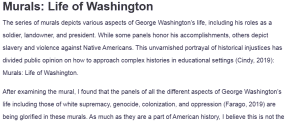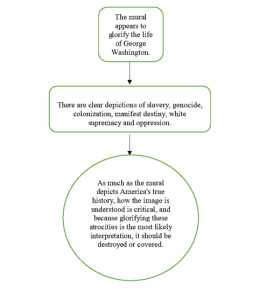Murals: Life of Washington
The series of murals depicts various aspects of George Washington’s life, including his roles as a soldier, landowner, and president. While some panels honor his accomplishments, others depict slavery and violence against Native Americans. This unvarnished portrayal of historical injustices has divided public opinion on how to approach complex histories in educational settings (Cindy, 2019): Murals: Life of Washington.
After examining the mural, I found that the panels of all the different aspects of George Washington’s life including those of white supremacy, genocide, colonization, and oppression (Farago, 2019) are being glorified in these murals. As much as they are a part of American history, I believe this is not the best way to be educated about it. I believe that more context would be important in such a public mural especially one that condemns this tragic history of America. However, this does not come across from the murals; instead, as I mentioned above, the context meaning one gets from the murals is that the different aspects of Washington’s life are being worshipped.
To explain my perspective, I will use an example; for instance, a campaign against femicide runs in a country, and an artist paints a mural to help the campaign. The mural is of a man strangling a woman to death, and just that, nothing else is added to the painting. This mural shows something that has happened to women repeatedly, but putting it up there like that sends different messages.
While we would like to believe that everyone will see it as a condemnation of the act and that that is the message everyone will get from the mural, this is not the case. Society is riddled with misogynists who will interpret this mural in their own way, and all women, but especially those who have been victims, will also have their way of interpretation.
To summarize, the first impression of the murals is that they glorify the life of George Washington. This life included some atrocious acts like slavery, genocide, colonization, manifest destiny, white supremacy, and oppression. As much as this is part of American History, more context should be added to show that it is only that, history and that it is not tolerated today, to avoid any misunderstandings from the first impression. If altering it is no option, think that the painting should be covered up or removed entirely.
Diagram
References
Cindy. (2019). “Life of Washington” by Victor Arnautoff. Art and Architecture – SF. https://artandarchitecture-sf.com/life-of-washington-by-victor-arnautoff.html
Farago, J. (2019). Depicting Washington’s ugly history sparks debate at San Francisco high school. The New York Times. https://www.nytimes.com/2019/04/11/arts/design/george-washington-murals-ugly-history-debated.html
ORDER A PLAGIARISM-FREE PAPER HERE
We’ll write everything from scratch
Question
Murals
Read/review the following resources for this activity:
- Textbook: Chapter 3
- Lesson
Introduction
“Observation is key to diagnosis, and art can teach students to slow down and really look,” said Craig Klugman, a bioethicist and medical anthropologist at DePaul University who is a co-author of a study on using art to enhance the observational skills of nursing students. “A clinician might notice one thing about a patient, such as dirty hands or torn clothes, and jump to conclusions without looking more closely.
We found that art can teach students to see both the big picture and small details that can be easily overlooked,” he said. In physical examinations, it’s important for clinicians to remove this type of bias, explained Klugman, in order to make only evidence-based observations that are free of bias (Krugman & Beckmann-Mendez, 2015).
George Washington High School in San Francisco, California, is the site of a mural, “Life of Washington,” painted by Depression-era artist Victor Arnautoff. In 2018, the mural became the subject of controversy when some parents and students wanted the murals removed as racially and ethnically offensive while others vigorously defended the murals (Tucker, 2019)
Nancy Truong, a 2013 graduate of the school. “This mural is not teaching students about the history of slavery and indigenous genocide under George Washington or other white settlers. Instead, it is teaching students to normalize violence and death of our black and indigenous community” (Tucker, 2019, para. 4).
Supporters argued the historic work is an important piece of art that is actually critical of oppression and imperialism and that destroying it or covering it equates to book burning. “’They should not be removed,’ said George Wright. ‘Removing them represents censorship as well as a reactionary moment in time’” (Tucker, 2019, More Mural Coverage section ).

Murals: Life of Washington
Do an online search about this controversy (suggested search ). Be sure to look at the murals, taking careful note of the mural panels contained in them. Should the panels be removed or covered over, or should they stay in place? With whom do you agree, and why?
Think: Ask yourself: What do I see? What do I see that makes me think that? What more do I see? Examine your reasoning. Does it demonstrate the important standards of critical thinking? What are your premises for your opinion? Do you make reasonable inferences from the observed facts? Are your assumptions warranted?
Write: Write a short paper in which you express your conclusion about what should be done with these murals.
- Be sure to include your reasons and evidence (in the form of references with in-text citations) that supports your opinion.
- At the end of your paper, include a summary and diagram of your argument.
- This paper must be no more than 300 words, or about 1.5 pages in length, not including the title page diagram and reference page.
Writing Requirements
- Length: 1.5 pages
- 1-inch margins
- Double spaced
- 12-point Times New Roman font
- Title page
- References page (lesson/textbook citation and outside source citation in APA format)


